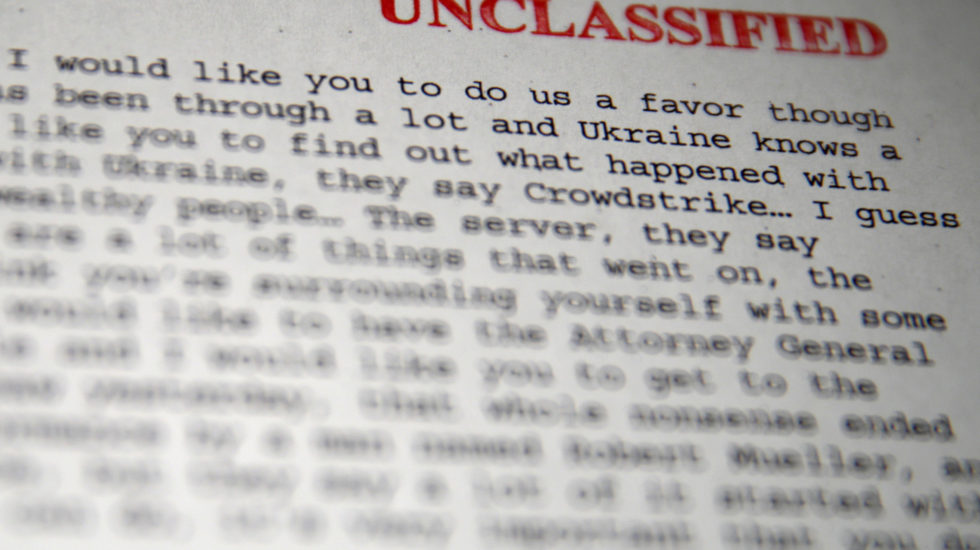On Oct. 3, Trump did it again, this time publicly: He urged China to investigate former Vice President Joe Biden. The public has yet to see the complete transcript of Trump’s July 25 call with Ukrainian President Volodymyr Zelensky. But the White House memorandum summarizing their exchange reveals a key point: Trump’s request for “dirt” on Biden was actually the second item on his “to do” list for Zelensky.
At the top of Trump’s agenda was a request for help in undermining America’s intelligence community, the FBI, and the Justice Department. As the cover-up collapses, we’re learning that Trump is a repeat offender.
“Do Us A Favor Though…”
When the July 25 call began, Trump was singlehandedly withholding previously authorized military aid that Ukraine needed desperately to resist Russian aggression. Even Senate Majority Leader Mitch McConnell (R-KY) couldn’t explain Trump’s delay. After reminding Zelensky “the United States has been very, very good to Ukraine,” Trump said:
“I would like you to do us a favor though….”
He then asked Zelensky to work with Rudy Giuliani and Attorney General William Barr to revive a conspiracy theory that the CIA, FBI, every other US intelligence agency, and special counsel Robert Mueller debunked long ago: that Ukraine, rather than Russia, was responsible for the attack on the 2016 US presidential election:
“The server, they say Ukraine has it… [T]hey say a lot of it started with Ukraine.”
Only then did Trump turn to “the other thing” — helping Giuliani and Barr get dirt on Biden. Plenty of people knew that Trump had done something wrong. Their actions reveal what prosecutors call “consciousness of guilt.”
Who Denied Knowing About The Call?
Secretary of State Mike Pompeo initially feigned ignorance about the entire episode:
Three days later, Pompeo admitted that he was on the call.
Initially, Vice President Mike Pence said that the memorandum summarizing Trump’s call “completely vindicated” Trump. Pence’s defenders are now saying that, although he should have had access to the transcript within hours of the call, he probably didn’t read it or it didn’t “fully register.”
On Oct. 2, The Washington Post reported that Pence’s national security adviser, Keith Kellogg, was on the call and that the transcript was probably in the briefing book Pence took to Warsaw when he met with Zelensky on Sept. 1. That’s when Pence told Zelensky personally that US military aid would not be forthcoming until Ukraine took more aggressive action on “corruption.”
Eventually, we’ll learn the complete roster of everyone who knew the truth and remained silent.
Who Hid The Evidence?
The White House buried the records of Trump’s call in a repository for super-secret intelligence. Experts familiar with the system say that Trump’s phone calls with foreign leaders aren’t close to qualifying for such treatment. So how did they get there?
“Administration officials say John Eisenberg, the White House deputy counsel for national security affairs and a national security legal adviser, directed the Ukraine transcript call be moved to the separate highly classified system, as detailed in the whistleblower complaint. That system is normally reserved for ‘code word’ documents that are extremely sensitive, such as covert operations,” CNN reported.
But until October 2018, Eisenberg’s boss was White House counsel Don McGahn. Then Emmet Flood took over for two months until Pat Cipollone became McGahn’s permanent replacement.
What Else Remains Hidden?
That leads to one of the most important lines in the whistleblower’s complaint:
“According to White House officials I spoke with, this was ‘not the first time’ under this Administration that a Presidential transcript was placed into this codeword-level system solely for the purpose of protecting politically sensitive—rather than national security sensitive—information.”
Now we’re learning about more troubling conversations during which Trump used foreign policy for personal gains:
- May 10, 2017: “President Trump told two senior Russian officials in a 2017 Oval Office meeting that he was unconcerned about Moscow’s interference in the 2016 US presidential election because the United States did the same in other countries, an assertion that prompted alarmed White House officials to limit access to the remarks to an unusually small number of people,” The Washington Post reported last week. [Emphasis supplied]
- Trump’s calls with Vladimir Putin and the Saudi Crown Prince Mohammed bin Salman went into the super-secret system, according to CNN.
- “In Recent Weeks”: Trump called Australian Prime Minister Scott Morrison seeking help that, according to The New York Times, “Trump hopes will discredit the Mueller investigation…. The White House curbed access to a transcript of the call — which the president made at Mr. Barr’s request — to a small group of aides, one of the officials said. The restriction was unusual and similar to the handling of a July call with the Ukrainian president….”
- July 26, 2019: The day after his call to Zelensky, Trump asked British Prime Minister Boris Johnson for help in discrediting special counsel Robert Mueller’s investigation, according to The Times of London.
What Did They Know And When Did They Know It?
Despite the herculean efforts of President Richard Nixon and his allies, Nixon’s own words eventually reached the public. Former White House counsel John Dean counted 21 lawyers involved in Watergate wrongdoing. Some of them, including Attorney General John Mitchell and Dean himself, went to prison. Many more lost their law licenses.
Start counting.
Steven J. Harper is a regular contributor to News & Guts and the creator/curator of the Trump-Russia Timeline. He’s an attorney, adjunct professor at Northwestern University Law School, and author of several books, including Crossing Hoffa — A Teamster’s Story and The Lawyer Bubble — A Profession in Crisis. He blogs at The Belly of the Beast. Follow him on Twitter (@StevenJHarper1).



